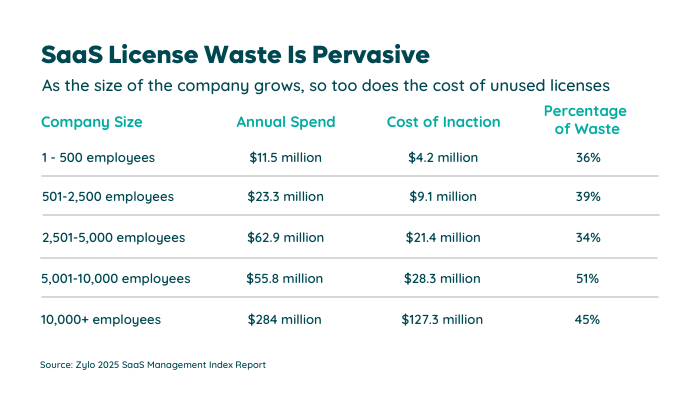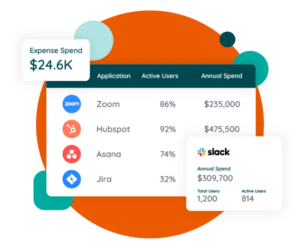Table of Contents
For most organizations, their SaaS portfolio scales alongside their organization. This is only natural, more employees require more seats. However, as SaaS portfolios grow, so does the amount of money you’re wasting on it. At least, that’s what happens without proper visibility.
After the explosion of SaaS in recent years, organizations across industries are leaving behind the growth-at-all-costs mentality in favor of long-term sustainability. That means it’s time to optimize SaaS spend and cut waste wherever possible. But, how much waste are we really seeing (and not seeing) in SaaS portfolios?
Let’s dive in.
How Much Is Wasted Every Year on SaaS
The average organization today wastes $21M a year on unused SaaS licenses alone. These are licenses not driving value for the organization, and often fly under the radar as shadow IT.
To break that down further, let’s take a look at the average annual wasted spend based on employee count.
- 1 – 500 employees: $4.2M
- 501 – 2,500 employees: $9.1M
- 2,501 – 5,000 employees: $21.4M
- 5,001 – 10,000 employees: $28.3M
- 10,001+ employees: $127.3M

As you can see, the larger the enterprise, the greater the waste. Which is, of course, only to be expected. Software spending is second only to headcount and grows alongside the organization itself. Nonetheless, you can’t afford to let a penny go to waste regardless if you’re an organization of 500 or 5,000.
The economic times we’re seeing today have pushed organizations to focus on capital preservation wherever possible. Software is an excellent place to start.
Why Managing SaaS Spend Is Important
Anytime a license goes unused, that’s money just left on the table. Your investment in that solution is not driving value and takes up resources better spent elsewhere. Unfortunately, the average organization only utilizes 47% of its SaaS licenses.
That remaining 53% is completely wasted and ripe for utilization. Organizations making the most of their licenses are reaching a utilization rate of at least 90%.
Being able to reclaim that investment and put it to use elsewhere is paramount to building a sustainable business, whether the economy is on a decline or not.
How Did This Happen?
Why are so many organizations leaving literal millions of dollars on the table? Well, this is in part a symptom of the explosion of SaaS we’ve seen in recent years.
First, almost everyone in your organizations can expense SaaS – from C-suite to individual employees. For example, imagine your organization has an enterprise contract for a given software. However, employees, especially new employees, may be unaware of this contract. Therefore, when they find a need for a solution, they expense it themselves. This represents a major source of duplicate and redundant software we see today.
That’s why it’s important from the get-go to have a plan to onboard employees with SaaS in mind and enable them to use and request this software.
Then there’s the lack of visibility in the SaaS portfolio this decentralized purchasing creates. After all, you can’t manage what you can’t see. Gaining insights into your entire portfolio via SaaS inventory management allows you to make informed data-based decisions to rationalize and rightsize your tech stack.
Utilization rates show you where licenses are going unused, and give you an opportunity to reassign them to other employees that need them. Should you have more seats than you need, then it’s an opportunity to either eliminate a solution or reduce the number of seats when it’s time to renew.
However, none of this can happen without that visibility, and that’s the prime culprit behind the waste we see today.
How to Identify and Eliminate Waste
So, SaaS spend is being wasted. What can you do about it? Well, it’s time to start practicing SaaS management.
Use a SaaS Management Platform to Get Visibility
First, you need to start by building visibility into your SaaS stack.
 You could try the traditional method of tracking everything in spreadsheets and updating them regularly. However, the modern state of SaaS shows us that the environment is constantly changing with SaaS leaving and entering the environment. The spreadsheet method offers hundreds of hours of work that’s constantly outdated and with very few insights into your SaaS.
You could try the traditional method of tracking everything in spreadsheets and updating them regularly. However, the modern state of SaaS shows us that the environment is constantly changing with SaaS leaving and entering the environment. The spreadsheet method offers hundreds of hours of work that’s constantly outdated and with very few insights into your SaaS.
That’s why a SaaS Management Platform (SMP) is more than a nice-to-have solution, it’s a necessity.
An SMP Allows you to:
- Discover Saving Opportunities with Visibility – An SMP allows you to establish a comprehensive view of your entire SaaS portfolio. Zylo’s AI- and machine learning-powered Discovery Engine finds 100% of your SaaS through financial discovery. Even the often miscategorized expenses.
- Learn Valuable Insights – Zylo, for example, surfaces personalized, prioritized, and actionable recommendations to drive your rightsizing and savings initiatives. All of which you get in a single view to determine what actions you can take for the greatest return.
- Understand Application Usage – As we mentioned before, understanding usage is essential to optimizing SaaS spend. An SMP like Zylo can put your real-time application usage insights from across your entire organization in a single place.
- Automate License Management – Knowing usage is half the battle. Once you decide which opportunity to address, you need to take action and manage your SaaS licenses. Using automation, such as Zylo Workflows, reduces the time it takes to harvest unused licenses or downgrade underutilized licenses.
In short: An SMP means no more spreadsheets and no more chasing shadow IT.
Guide to Managing SaaS Costs
Learn MoreStart Small
SaaS Management isn’t a one-and-done solution that fixes your problems overnight. It’s an ongoing program to keep your SaaS portfolio optimized. As such, you’ll want to start small and build your management program over time rather than starting with sweeping changes.
Start with something as simple as your utilization threshold. For example, address all your applications with a utilization rate of less than 50%. Once they’re covered in an ongoing management program, move up to those over 50%. From there you can safely build to that recommended 90 to 95% utilization rate.
Adjust Now, Plan for Renewals Tomorrow
SaaS renewals are your biggest opportunity to drive savings. As we like to say, this is where the rubber meets the road. Renewals are an opportunity to rightsize licenses and reduce the quantity in your contract for hard savings.
Unfortunately, renewals only come once a year or every two or three years. That leaves very little opportunity to drive hard savings until that time – except plan ahead and understand what you need when the time comes. And planning is important. Despite the space between renewals, organizations experience a renewal almost every day. So, it’s easy to get overwhelmed.
However, there are still other actions you can take during your contract term. Although you can’t recoup the hard costs, you can reclaim licenses. Identify seats that are not being utilized and reassign them where possible. If there’s nowhere to assign them, they’re still available if the need arises. This is a strong cost-avoidance measure.
Stop the Waste with Zylo
The average SaaS portfolio today is plagued with waste, and we can only expect it to get worse as organizations grow. Worse yet, tackling waste can be a costly and time-consuming process – if done the wrong way.
That’s why Zylo is dedicated to helping organizations get SaaS right.
Check out our Guide to Managing SaaS Costs ebook to see how SaaS Management can optimize your stack and reduce the waste.


